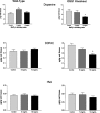Lack of the DNA repair enzyme OGG1 sensitizes dopamine neurons to manganese toxicity during development
- PMID: 16358418
- PMCID: PMC6009123
- DOI: 10.3727/000000005783992007
Lack of the DNA repair enzyme OGG1 sensitizes dopamine neurons to manganese toxicity during development
Abstract
Onset of Parkinson's disease (PD) and Parkinson-like syndromes has been associated with exposure to diverse environmental stimuli. Epidemiological studies have demonstrated that exposure to elevated levels of manganese produces neuropathological changes localized to the basal ganglia, including neuronal loss and depletions in striatal dopamine content. However, understanding the mechanisms associated with manganese neurotoxicity has been hampered by the lack of a good rodent model. Elevated levels of 8-hydroxy-2'-deoxyguanosine (oxo8dG) have been found in brain areas affected in PD. Whether increased DNA damage is responsible for neuronal degeneration or is a mere epiphenomena of neuronal loss remains to be elucidated. Thus, by using mice deficient in the ability to remove oxo8dG we aimed to determine if dysregulation of DNA repair coupled to manganese exposure would be detrimental to dopaminergic neurons. Wild-type and OGG1 knockout mice were exposed to manganese from conception to postnatal day 30; in both groups, exposure to manganese led to alterations in the neurochemistry of the nigrostriatal system. After exposure, dopamine levels were elevated in the caudate of wild-type mice. Dopamine was reduced in the caudate of OGG1 knockout mice, a loss that was paralleled by an increase in the dopamine index of turnover. In addition, the reduction of dopamine in caudate putamen correlated with the accumulation of oxo8dG in midbrain. We conclude that OGG1 function is essential in maintaining neuronal stability during development and identify DNA damage as a common pathway in neuronal loss after a toxicological challenge.
Figures




Similar articles
-
Exposure to lead and the developmental origin of oxidative DNA damage in the aging brain.FASEB J. 2006 Apr;20(6):788-90. doi: 10.1096/fj.05-5091fje. Epub 2006 Feb 16. FASEB J. 2006. PMID: 16484331
-
Manganese-induced neurotoxicity: the role of astroglial-derived nitric oxide in striatal interneuron degeneration.Toxicol Sci. 2006 Jun;91(2):521-31. doi: 10.1093/toxsci/kfj150. Epub 2006 Mar 21. Toxicol Sci. 2006. PMID: 16551646
-
Acute neurotoxic effects of the fungal metabolite ochratoxin-A.Neurotoxicology. 2006 Jan;27(1):82-92. doi: 10.1016/j.neuro.2005.07.004. Epub 2005 Sep 2. Neurotoxicology. 2006. PMID: 16140385
-
Oxidative damage in nucleic acids and Parkinson's disease.J Neurosci Res. 2007 Apr;85(5):919-34. doi: 10.1002/jnr.21191. J Neurosci Res. 2007. PMID: 17279544 Review.
-
Manganese-Induced Parkinsonism Is Not Idiopathic Parkinson's Disease: Environmental and Genetic Evidence.Toxicol Sci. 2015 Aug;146(2):204-12. doi: 10.1093/toxsci/kfv099. Toxicol Sci. 2015. PMID: 26220508 Free PMC article. Review.
Cited by
-
Catalytic activity of OGG1 is impaired by Zinc deficiency.DNA Repair (Amst). 2024 Feb;134:103628. doi: 10.1016/j.dnarep.2024.103628. Epub 2024 Jan 10. DNA Repair (Amst). 2024. PMID: 38228016
-
Mitochondrial OGG1 expression reduces age-associated neuroinflammation by regulating cytosolic mitochondrial DNA.Free Radic Biol Med. 2023 Jul;203:34-44. doi: 10.1016/j.freeradbiomed.2023.03.262. Epub 2023 Apr 1. Free Radic Biol Med. 2023. PMID: 37011700 Free PMC article.
-
Activated or Impaired: An Overview of DNA Repair in Neurodegenerative Diseases.Aging Dis. 2022 Jul 11;13(4):987-1004. doi: 10.14336/AD.2021.1212. eCollection 2022 Jul 11. Aging Dis. 2022. PMID: 35855336 Free PMC article.
-
3D reconstructed brain images reveal the possibility of the ogg1 gene to suppress the irradiation-induced apoptosis in embryonic brain in medaka (Oryzias latipes).J Radiat Res. 2022 May 18;63(3):319-330. doi: 10.1093/jrr/rrac005. J Radiat Res. 2022. PMID: 35276012 Free PMC article.
-
A Novel Role for the DNA Repair Enzyme 8-Oxoguanine DNA Glycosylase in Adipogenesis.Int J Mol Sci. 2021 Jan 25;22(3):1152. doi: 10.3390/ijms22031152. Int J Mol Sci. 2021. PMID: 33503804 Free PMC article.
References
-
- Arai T.; et al. High accumulation of oxidative DNA damage, 8-hydroxyguanine, in Mmh/Ogg1 deficient mice by chronic oxidative stress. Carcinogenesis 23(12):2005–2010; 2002. - PubMed
-
- Bernheimer H.; et al. Brain dopamine and the syndromes of Parkinson and Huntington. Clinical, morphological and neurochemical correlations. J. Neurol. Sci. 20(4):415–455; 1973. - PubMed
-
- Bogdanov M.; et al. Increased oxidative damage to DNA in ALS patients. Free Radic. Biol. Med. 29(7):652–658; 2000. - PubMed
-
- Bradford M. M. A rapid and sensitive method for the quantitation of microgram quantities of protein utilizing the principle of protein-dye binding. Anal. Biochem. 72:248–254; 1976. - PubMed
-
- Brenneman K. A.; et al. Manganese-induced developmental neurotoxicity in the CD rat: Is oxidative damage a mechanism of action? Neurotoxicology 20(2–3): 477–487; 1999. - PubMed
Publication types
MeSH terms
Substances
Grants and funding
LinkOut - more resources
Full Text Sources
Research Materials
